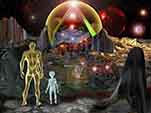By Michael Snyder
The wait for the next “Lehman Brothers moment” is over. On Friday, we witnessed the second biggest bank failure in U.S. history. The stunning collapse of Silicon Valley Bank is shaking the financial world to the core. As of the end of last year, the bank had 175 billion dollars in deposits, and approximately 151 billion dollars of those deposits were uninsured. In other words, a lot of wealthy individuals and large companies are in danger of being wiped out. In particular, this is being described as an “extinction level event” for tech startups, because thousands of them did their banking with SVB. I cannot even begin to describe how cataclysmic this is going to be for the tech industry as a whole.
There is so much to cover, and so let me try to take this one step at a time.
Rumors of trouble at SVB had sparked a massive bank run in recent days, and regulators moved quickly on Friday to permanently shut the bank down…
Financial regulators have closed Silicon Valley Bank and taken control of its deposits, the Federal Deposit Insurance Corp. announced Friday, in what is the largest U.S. bank failure since the global financial crisis more than a decade ago.
The collapse of SVB, a key player in the tech and venture capital community, leaves companies and wealthy individuals largely unsure of what will happen to their money.
We haven’t seen anything like this in a very long time.
In fact, it is being reported that this is the second biggest bank failure in all of U.S. history…
The closure marks the biggest bank failure since the 2008 financial crisis and the second-largest in U.S. history after Washington Mutual collapsed during that industry-wide meltdown, according to FDIC data.
As of the end of December, the Santa Clara, California-based bank — the 16th largest bank in the country — had $209 billion in assets with more than $175 billion in deposits. As with other FDIC-member banks, SVB deposits are insured up to $250,000 per depositor.
The good news is that anyone that had less than $250,000 in the bank will be covered by FDIC insurance…
The FDIC’s standard insurance covers up to $250,000 per depositor, per bank, for each account ownership category. The FDIC said uninsured depositors will get receivership certificates for their balances. The regulator said it will pay uninsured depositors an advanced dividend within the next week, with potential additional dividend payments as the regulator sells SVB’s assets.
Whether depositors with more than $250,000 ultimately get all their money back will be determined by the amount of money the regulator gets as it sells Silicon Valley assets or if another bank takes ownership of the remaining assets. There were concerns in the tech community that until that process unfolds, some companies may have issues making payroll.
Unfortunately, as I noted above, the vast majority of the deposits with SVB exceeded the $250,000 threshold and were thus uninsured…
As we noted before, while the FDIC noted that SVIB had $175BN in deposits as of Dec 31, note that some $151.5BN of these are uninsured, which means they get exactly zero although a sizable number of them likely pulled their deposits in the past few days.
As SVB assets are liquidated, hopefully those that had uninsured deposits at SVB will eventually see some of their money.
But for now, many of them are facing a complete and total nightmare.
For example, one tech CEO named Ashley Turner is freaking out because she had “at least $10m deposited with SVB”…
Ashley Tyrner, CEO of Boston wellness firm FarmboxRx, said she had at least $10m deposited with SVB and has been frantically calling her banker. She said it had been ‘the worst 18 hours of my life.’
Can you imagine how she must be feeling at this moment?
Sadly, she is far from alone.
The CEO of YCombinator, Garry Tan, says that what we are looking at is an “extinction level event” for tech startups…
There are thousands of US startups that banked at SVB, often as their *sole bank*. $250K per account is not going to last long.
The #1 pressing issue for these startups is *payroll* – you can’t have people work if you can’t pay them.
This means mass furlough.
It might mean thousands of startups die before the FDIC gets through its receivership process and releases the funds.
From what I hear, there are venture debt options coming from providers like Brex, but we’re going to need *a lot* of options in order to avoid a mass shutdown of all American startups in the next few weeks.
This is an *extinction level event* for startups and will set startups and innovation back by 10 years or more.
I wish that I could tell you that he is wrong.
But I cannot.
When news of what was being done to SVB hit Wall Street, bank stocks started falling precipitously.
Is this the beginning of a horrifying new crisis for the financial industry?
Well, Michael Burry is suggesting that the collapse of SVB could be “our Enron”…
Michael Burry, the eccentric investor featured in the 2015 film “The Big Short,” warned: “It is possible today we found our Enron.”
And billionaire Bill Ackman is already suggesting that the federal government should bail out the bank…
Billionaire investor Bill Ackman says the US government should consider a “highly dilutive” bailout of Silicon Valley Bank amid jitters about its financial position.
The bank’s failure “could destroy an important long-term driver of the economy as VC-backed companies rely on SVB for loans and holding their operating cash,” Ackman said in a series of tweets on Thursday. “If private capital can’t provide a solution, a highly dilutive gov’t preferred bailout should be considered,” he said.
At this point, I doubt that Congress will be willing to do anything.
But if that doesn’t happen, Ackman is warning us that there could soon be bank runs at other major banks…
He added: “The risk of failure and deposit losses here is that the next, least well-capitalized bank faces a run and fails and the dominoes continue to fall.”
“That is why gov’t intervention should be considered.”
Once the dominoes start falling, it will be difficult to stop the process.
In fact, the situation is already so dire that Peter Schiff is proclaiming that we are “on the verge of a much bigger collapse than 2008”…
“The U.S. banking system is on the verge of a much bigger collapse than 2008,” said economist Peter Schiff, known for his dire predictions.
“Banks own long-term paper at extremely low interest rates. They can’t compete with short-term Treasuries. Mass withdrawals from depositors seeking higher yields will result in a wave of bank failures.”
Of course a lot of the “experts” in the mainstream media never saw this coming.
Just last month, CNBC’s Jim Cramer was actually telling his viewers that they should buy SVB stock…
CNBC analyst Jim Cramer is once again being pilloried on social media after a clip resurfaced showing the “Mad Money” host recommending viewers buy shares of Silicon Valley Bank’s parent company, which owns the tech-driven commercial lender that swiftly collapsed on Friday.
“The ninth-best performer to date has been SVB Financial (the bank’s parent company). Don’t yawn,” Cramer told viewers during a Feb. 8 episode of “Mad Money.”
Cramer listed SVB Financial among his “biggest winners of 2023 … so far” alongside blue-chip stocks such as Meta, Tesla, Warner Bros. Discovery, and Norwegian Cruise Line.
Unfortunately, SVB’s situation is not unique.
Thanks to rapidly rising interest rates, many other banks are also sitting on mountains of Treasury bills that have lost a lot of value…
Banks are big investors in assets like Treasury bills because they need lots of safe places to park their cash. Many financial institutions piled into these investments during a period of historically-low interest rates that spanned the early years of the pandemic, as banks took in tons of new deposits and lending was somewhat restrained.
But now the Fed is hiking rates at a rapid clip, with Fed Chair Jay Powell warning earlier this week the central bank may have to speed up the pace of its rate increases to cool the economy further. The problem that creates for banks is simple: higher rates lower the value of their existing bonds.
For an extensive break down of why this is causing so much distress for our banks right now, I would highly recommend reading this excellent article.
As I have been telling my readers, our system simply cannot handle higher rates at this point.
But the “experts” at the Fed assured all of us that they knew exactly what they were doing.
Now they have caused one of the biggest bank failures in U.S. history, and much worse is on the way if they do not reverse course.
But I don’t expect the “experts” at the Fed to listen to any of us.
They are just going to keep doing what they are doing, and we are all going to have to live with the consequences.
----
About the Author: My name is Michael and my brand new book entitled “End Times” is now available on Amazon.com. In addition to my new book I have written six other books that are available on Amazon.com including “7 Year Apocalypse”, “Lost Prophecies Of The Future Of America”, “The Beginning Of The End”, and “Living A Life That Really Matters”. (#CommissionsEarned) When you purchase any of these books you help to support the work that I am doing, and one way that you can really help is by sending copies as gifts to family and friends. Time is short, and I need help getting these warnings into the hands of as many people as possible. I have published thousands of articles on The Economic Collapse Blog, End Of The American Dream and The Most Important News, and the articles that I publish on those sites are republished on dozens of other prominent websites all over the globe. I always freely and happily allow others to republish my articles on their own websites, but I also ask that they include this “About the Author” section with each article. The material contained in this article is for general information purposes only, and readers should consult licensed professionals before making any legal, business, financial or health decisions. I encourage you to follow me on social media on Facebook and Twitter, and any way that you can share these articles with others is definitely a great help. These are such troubled times, and people need hope.






































